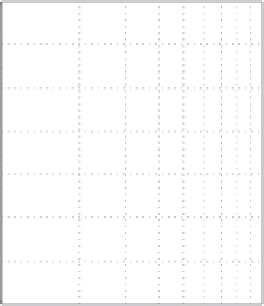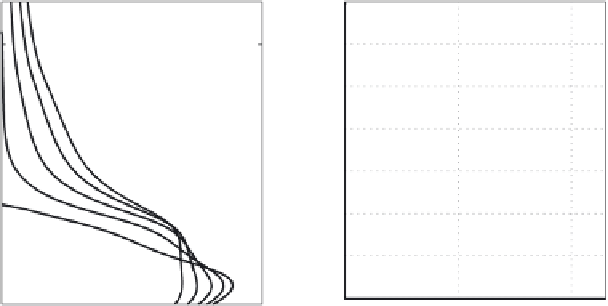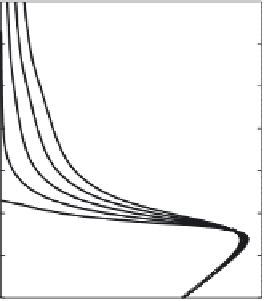Geoscience Reference
In-Depth Information
140
140
Day
Day
5
130
130
5
E
0
=
5V/m
E
0
= 0.5 V/m
γ = 0
120
120
γ = 0
4
4
110
110
3
3
100
100
90
90
2
2
80
80
1
1
70
70
10
1
10
2
100
1
2
4
6
8 110
T
e
/T
e0
T
e
/T
e0
Fig. 13.1.
Plots of the height dependency of the electron temperature
T
e
(
z
) caused
by the right-polarized HF-wave in the dayside ionosphere. The intensities of the
wave electric field are 0
.
5 V/m (left) and 5 V/m (right) at the bottom ionosphere.
The HF pump wave frequencies
ω
are shown at lines and given in units of 10
7
rad/s
is given by
e
2
3
mδ
e
E
2
T
e
=
T
e
0
+
ω
ce
)
2
+
ν
en
(
T
e
)
.
(13.2)
(
ω
±
For the definition of a part of the total Pedersen and Hall conductivities
associated with heating of the ionosphere by a high-powered HF-wave far from
the reflection point be defined at the 65 km which is chosen as the bottom of
the ionosphere. In the non-linear geometrical optics approximation, the HF-
wave intensity is described by [14]
dE
dz
+
ω
c
κ
(
E
)
E
=0
.
(13.3)
Here
κ
=Im
n
, the refractive index
n
is defined by the Appleton-Hartree
formula (see Chapter 12). The calculation procedure utilized in calculations
of
Σ
P
and
Σ
H
is the following. An intensity of the electric field
E
(
z
)ofa
non-linear wave (the right-hand and left-hand) within the ionosphere is com-
puted at every step of the integration of (13.3). Then, using (13.2), electron
temperatures is found at the corresponding heights.
Figure 13.1 shows the calculated height dependency of ratio
T
e
/T
e
0
of
the perturbed electron temperature
T
e
to the background
T
e
0
.
Both frames
show this ratio for the dayside ionosphere. The left frame is for the applied
electric field
E
=0
.
5 V/m and the right frame is for
E
=5V/matthe
bottom of the ionosphere
z
=65km.
E
(V/m ) at the height
z
(km) and an
effective radiation power
W
e
ff
(kW) of a ground equivalent transmitting dipole
are related as
E
=0
.
3
√
W/z
. So the chosen
E
correspond, respectively, to






















Search WWH ::

Custom Search